
| Genus List | Species List | Genus overview |
10a. Sculpture on face composed entirely of high, sharp carinae, which often anastomose to form areolae, but which may be regularly longitudinally parallel; first gastral tergite smooth or punctate, rarely feebly striate at anterior and/or posterior margins; base of scape never flattened: 20
10b. Sculpture on face shallow, a mixture of striae and foveae; first gastral tergite punctate to densely and finely striate; base of scape never flattened (see also 10c, d): 40
10c. Sculpture on face composed entirely of discrete, rounded foveae; distance between foveae greater than or equal to fovea diameter; interspaces generally varying from smooth and shiny to finely shagreened and with a silky luster; foveae uniformly covering face or restricted to anterior half or less, leaving posterior portion of face smooth; first gastral tergite smooth, striate, or punctate; base of scape terete or flattened: 100
10d. Sculpture on face composed of confluent, very shallow foveae; first gastral tergite finely longitudinally striate; base of scape terete (HW less than 1.0mm): pictipes

20a. first gastral tergite densely micropunctate over most of surface; sculpture on face uniformly areolate, with no longitudinal orientation, HW less than 1.05mm: belti
20b. first gastral tergite usually smooth and shining, occasionally with longitudinal rugulae anteriorly, or with longitudinal rugulae both anteriorly and posteriorly; sculpture on face often with at least some longitudinal orientation medially; HW greater than 1.05: 30
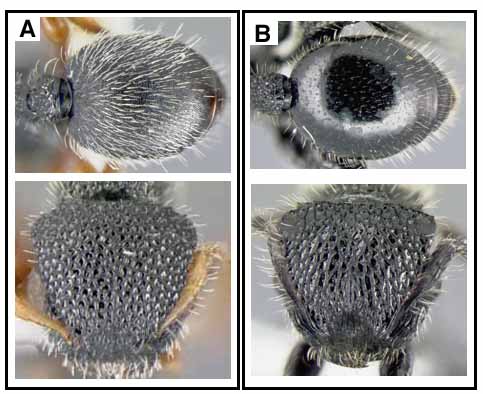
30a. Lateral portion of clypeus expanded, such that a trough is formed between it and torulus; in anterior view torulus is partially hidden; mesosoma length less than 1.9mm; side of dorsal face of propodeum often with a tooth or lobe mid-way between base of propodeum and base of propodeal spine: batesi
30b. Lateral portion of clypeus falls perpendicularly to base of torulus, such that in anterior view torulus is clearly visible; mesosoma length (ML) usually greater than 1.9mm; side of dorsal face of propodeum straight, with no tooth or lobe mid-way between base of propodeum and base of propodeal spine: mayri

40a. PtL/PtW (petiole length to width ratio) greater than 1.3; base of scape flattened, as wide as distal end: kempfi
40b. PtL/PtW less than 1.3; base of scape terete or somewhat flattened, gradually tapering to basal flange: 45
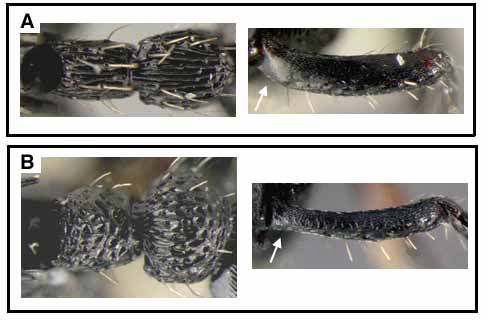
45a. Dorsal face of propodeum and first gastral tergite with relatively few setae, which are not strongly flattened; face with conspicuous longitudinal rugae, with variable development of small foveae; posterior face of forefemur smooth, or with faint carinae which do not extend the full length of femur: scabriusculus
45b. Dorsal face of propodeum and first gastral tergite with strongly flattened setae; setae moderately abundant, along median axis decumbent setae overlap by less than half their length or do not overlap; sculpture on face very shallow, foveae more conspicuous than rugae (see also 40c): 50
45c. Dorsal face of propodeum and first gastral tergite with abundant, strongly flattened setae; along median axis of first gastral tergite decumbent setae overlap by about half their length; sculpture on face very shallow, foveae more conspicuous than rugae (lateral lobes of mesonotum in the form of horizontal flanges which are blunt, posteriorly-directed, and project over the propodeal suture, such that in side view their vertically concave posteroventral margins obscure the median portion of the suture): impressus
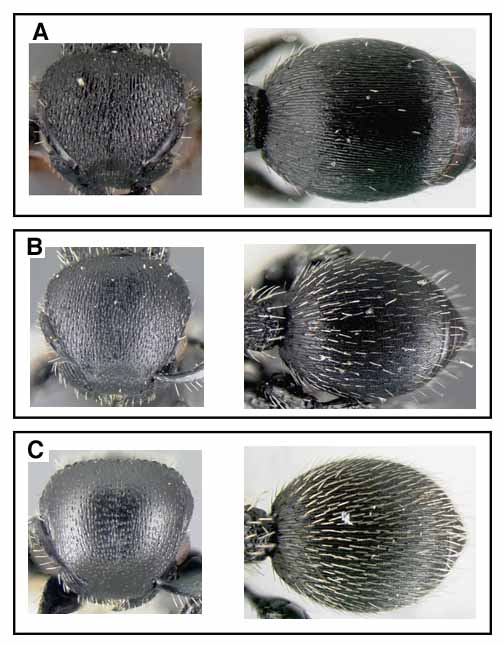
50a. first gastral tergite continuously striate from anterior to posterior border; face nearly or entirely devoid of erect setae: paleatus
50b. Striae on first gastral tergite fading out before attaining posterior margin; face with more than 10 erect setae: tortuguero

100a. first gastral tergite densely and finely striate over entire surface; erect setae stiff, short, sparse: 110
100b. first gastral tergite smooth or with striae confined to anterior one half; erect setae thin and flexuous, or absent: 120

110a. Base of scape flattened, as wide as distal end; HW greater than 1.20mm; petiole relatively long and thin, anterior face smooth and shining: kempfi
110b. Base of scape (above basal flange) subterete, narrower than distal end; HW less than 1.20mm; petiole relatively short and squat, anterior face with coarse transverse striae: hylaeus

120a. Base of scape (above basal flange) subterete, narrower than distal end; scape orange brown or black: 130
120b. Base of scape flattened, as wide as distal end; scape black: 140

130a. Face largely smooth and shining, weak foveae confined to anterior third; scape orange: coriarius
130b. Face uniformly foveate; scape black: eladio
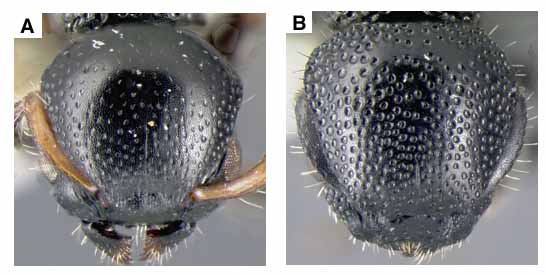
140a. first gastral tergite smooth and shiny, with scattered minute puncta, lacking longitudinal sculpture in Central America, with anterior longitudinal rugulae in Peru; mesosomal dorsum with abundant long flexuous setae: nalini
140b. first gastral tergite with anterior portion evenly longitudinally striate; mesosomal dorsum with sparse, short, stiff setae: attenuatus
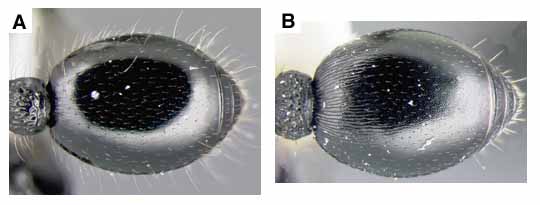
Page author:
John T. Longino, The Evergreen State College, Olympia WA 98505 USA. longinoj@evergreen.edu
Date of this version: 10 December 2002.